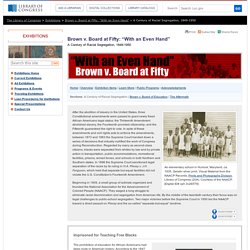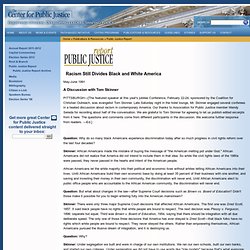

Jim Crow Laws - Separate Is Not Equal. “Marriages are void when one party is a white person and the other is possessed of one-eighth or more negro, Japanese, or Chinese blood.”

—Nebraska, 1911 “Separate free schools shall be established for the education of children of African descent; and it shall be unlawful for any colored child to attend any white school, or any white child to attend a colored school.” —Missouri, 1929 “All railroads carrying passengers in the state (other than street railroads) shall provide equal but separate accommodations for the white and colored races, by providing two or more passenger cars for each passenger train, or by dividing the cars by a partition, so as to secure separate accommodations.” —Tennessee, 1891 See more Jim Crow laws Restricted real-estate covenant In communities across the country, property owners signed agreements called restrictive covenants.
Protests of 1968. The protests of 1968 comprised a worldwide escalation of social conflicts, predominantly characterized by popular rebellions against military, capitalist, and bureaucratic elites, who retorted with an escalation of political repression.

In capitalist countries, these protests marked a turning point for the Civil Rights movement in the United States, which produced revolutionary movements like the Black Panther Party. In reaction to the Tet Offensive, protests also sparked a broad movement in opposition to the Vietnam War all over the United States and even into London, Paris, Berlin and Rome. Mass socialist or communist movements grew not only in the United States but also in most European countries. Civil Rights Movement - WorldHistoryProject.org. We Were There - The Greensboro Sit Ins. African American History Month 2013.
A Century of Racial Segregation 1849–1950 - Brown v. Board at Fifty: "With an Even Hand" An elementary school in Hurlock, Maryland, ca. 1935.

Gelatin silver print. Visual Material from the NAACP Records, Prints and Photographs Division, Library of Congress (20A). Courtesy of the NAACP. [Digital ID# cph 3c26579] After the abolition of slavery in the United States, three Constitutional amendments were passed to grant newly freed African Americans legal status: the Thirteenth Amendment abolished slavery, the Fourteenth provided citizenship, and the Fifteenth guaranteed the right to vote.
Beginning in 1909, a small group of activists organized and founded the National Association for the Advancement of Colored People (NAACP). Discover! Imprisoned for Teaching Free Blacks The prohibition of education for African Americans had deep roots in American history. Margaret Crittenden Douglass. Upholding School Segregation: The Roberts Case Five-year-old Sara Roberts was forced to walk past several white schools to reach the “colored” primary school. Charles Sumner. Plessy v. Phillip B. The 1950-60's Black Civil Rights Movement in America. The actions of the 1900's black civil rights movement, and a brief outline of the events that occurred.

America is advertised as the world's greatest democracy, the land of freedom and equality. However, as little as 40 years ago this slogan was far from the truth. African-Americans were discriminated against constantly, tortured and killed for no other reason than their skin color. Racism Still Divides Black and White America.
May-June 1991 A Discussion with Tom Skinner PITTSBURGH—[The featured speaker at this year's jubilee Conference, February 22-24, sponsored by the Coalition for Christian Outreach, was evangelist Tom Skinner.

Late Saturday night in the hotel lounge, Mr. Skinner engaged several conferees in a heated discussion about racism in contemporary America. Our thanks to Association for Public Justice member Wendy Sereda for recording about half of the conversation. Question: Why do so many black Americans experience discrimination today after so much progress in civil rights reform over the last four decades? The KKK and racial problems. The Ku Klux Klan was basically based in the south of America. Here they targeted those set free after the American Civil War - the African Americans. The KKK had never considered the former slaves as being free and terrorised Africa American families based in the South. America experienced great economic prosperity during the 1920's but not much of it filtered to the South. Racism mixed with anger at their economic plight formed a potent cocktail. Many different groups had emigrated to America over the years. Civil Rights Movement: Struggle for Integration.
The Civil Rights Movement is sometimes defined as a struggle against racial segregation that began in 1955 when Rosa Parks, the "seamstress with tired feet," refused to give up her seat to a white man on a bus in Alabama.

Brown v. Board of Education, the 1954 Supreme Court case that attacked the notion of "separate but equal," has also been identified as the catalyst for this extraordinary period of organized boycotts, student protests, and mass marches. These legendary events, however, did not cause the modern Civil Rights Movement, but were instead important moments in a campaign of direct action that began two decades before the first sit-in demonstration. The story of the American Civil Rights Movement is one of those tales that is told again and again and again, often with a few protagonists, a couple of key events, and one dramatic conclusion. Right? Well, not really. Absolutely. So, when did that movement emerge and how? Nope. Without a doubt!